本文大部分内容翻译自Illustrated Self-Attention, Step-by-step guide to self-attention with illustrations and code,仅用于学习,如有翻译不当之处,敬请谅解!
什么是Self-Attention(自注意力机制)?
如果你在想Self-Attention(自注意力机制)是否和Attention(注意力机制)相似,那么答案是肯定的。它们本质上属于同一个概念,拥有许多共同的数学运算。
一个Self-Attention模块拥有n个输入,返回n个输出。这么模块里面发生了什么?从非专业角度看,Self-Attention(自注意力机制)允许输入之间互相作用(“self”部分),寻找出谁更应该值得注意(“attention”部分)。输出的结果是这些互相作用和注意力分数的聚合。
一步步理解Self-Attention
理解分为以下几步:
- 准备输入;
- 初始化权重;
- 获取
key,query和value; - 为第1个输入计算注意力分数;
- 计算softmax;
- 将分数乘以values;
- 对权重化后的values求和,得到输出1;
- 对其余的输入,重复第4-7步。
注意:实际上,这些数学运算都是向量化的,也就是说,所有的输入都会一起经历这些数学运算。我们将会在后面的代码部分看到。
第一步:准备输入

在这个教程中,我们从3个输入开始,每个输入的维数为4。
Input 1: [1, 0, 1, 0]
Input 2: [0, 2, 0, 2]
Input 3: [1, 1, 1, 1]
第二步:初始化权重
每个输入必须由三个表示(看下图)。这些输入被称作key(橙色),query(红色)value(紫色)。在这个例子中,我们假设我们想要的表示维数为3。因为每个输入的维数为4,这就意味着每个权重的形状为4×3。
注意:我们稍后会看到
value的维数也是output的维数。
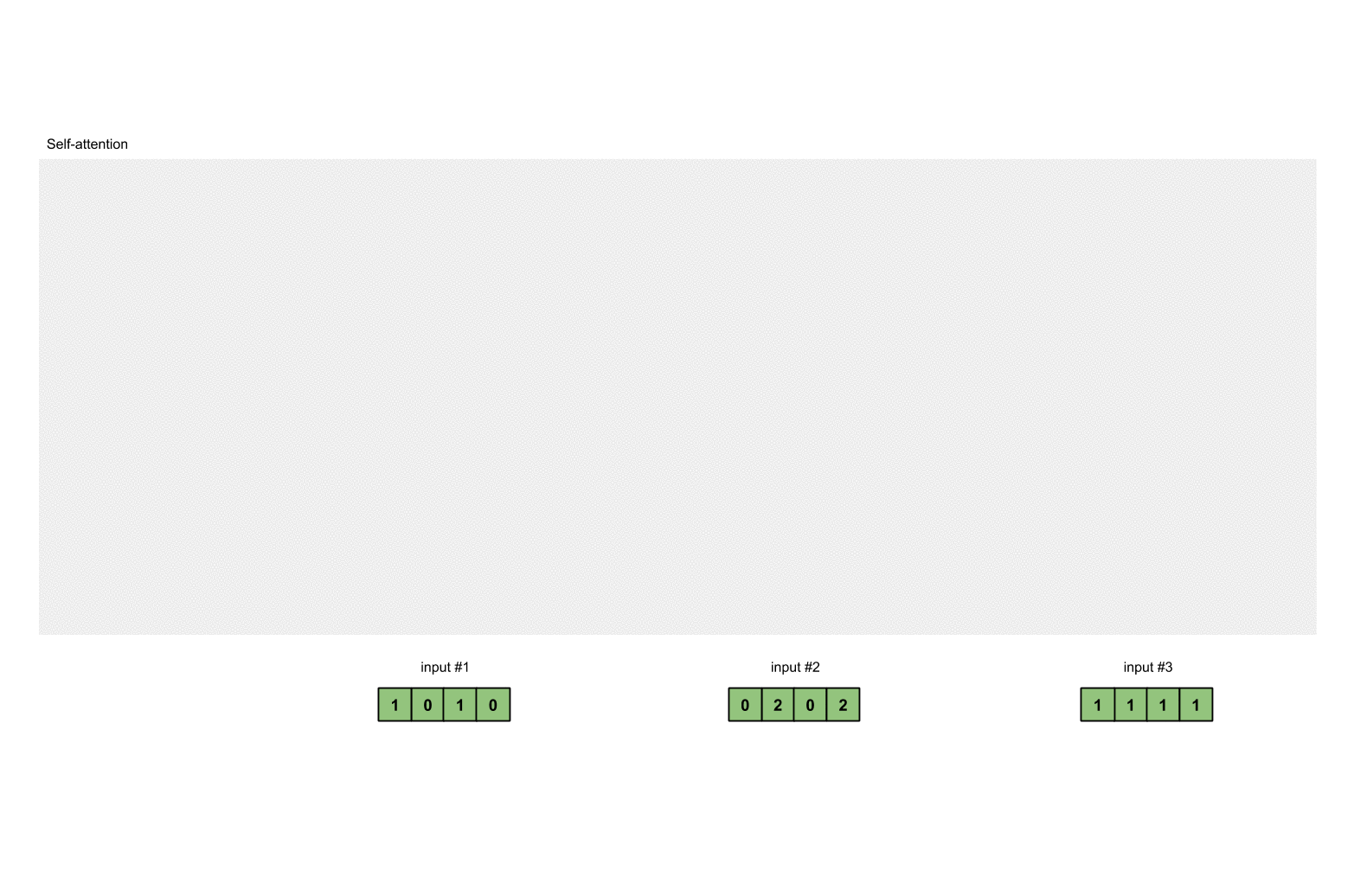
为了获取这些表示,每个输入(绿色)会乘以一个权重的集合得到keys,乘以一个权重的集合得到queries,乘以一个权重的集合得到values。在我们的例子中,我们初始化三个权重的集合如下。
key的权重:
[[0, 0, 1],
[1, 1, 0],
[0, 1, 0],
[1, 1, 0]]
query的权重:
[[1, 0, 1],
[1, 0, 0],
[0, 0, 1],
[0, 1, 1]]
value的权重:
[[0, 2, 0],
[0, 3, 0],
[1, 0, 3],
[1, 1, 0]]
注意: 在神经网络设置中,这些权重通常都是一些小的数字,利用随机分布,比如Gaussian, Xavier and Kaiming分布,随机初始化。在训练开始前已经完成初始化。
第三步:获取key,query和value;
现在我们有了3个权重的集合,让我们来给每个输入获取key,query和value。
第1个输入的key表示:
[0, 0, 1]
[1, 0, 1, 0] x [1, 1, 0] = [0, 1, 1]
[0, 1, 0]
[1, 1, 0]
利用相同的权重集合获取第2个输入的key表示:
[0, 0, 1]
[0, 2, 0, 2] x [1, 1, 0] = [4, 4, 0]
[0, 1, 0]
[1, 1, 0]
利用相同的权重集合获取第3个输入的key表示:
[0, 0, 1]
[1, 1, 1, 1] x [1, 1, 0] = [2, 3, 1]
[0, 1, 0]
[1, 1, 0]
更快的方式是将这些运算用向量来描述:
[0, 0, 1]
[1, 0, 1, 0] [1, 1, 0] [0, 1, 1]
[0, 2, 0, 2] x [0, 1, 0] = [4, 4, 0]
[1, 1, 1, 1] [1, 1, 0] [2, 3, 1]
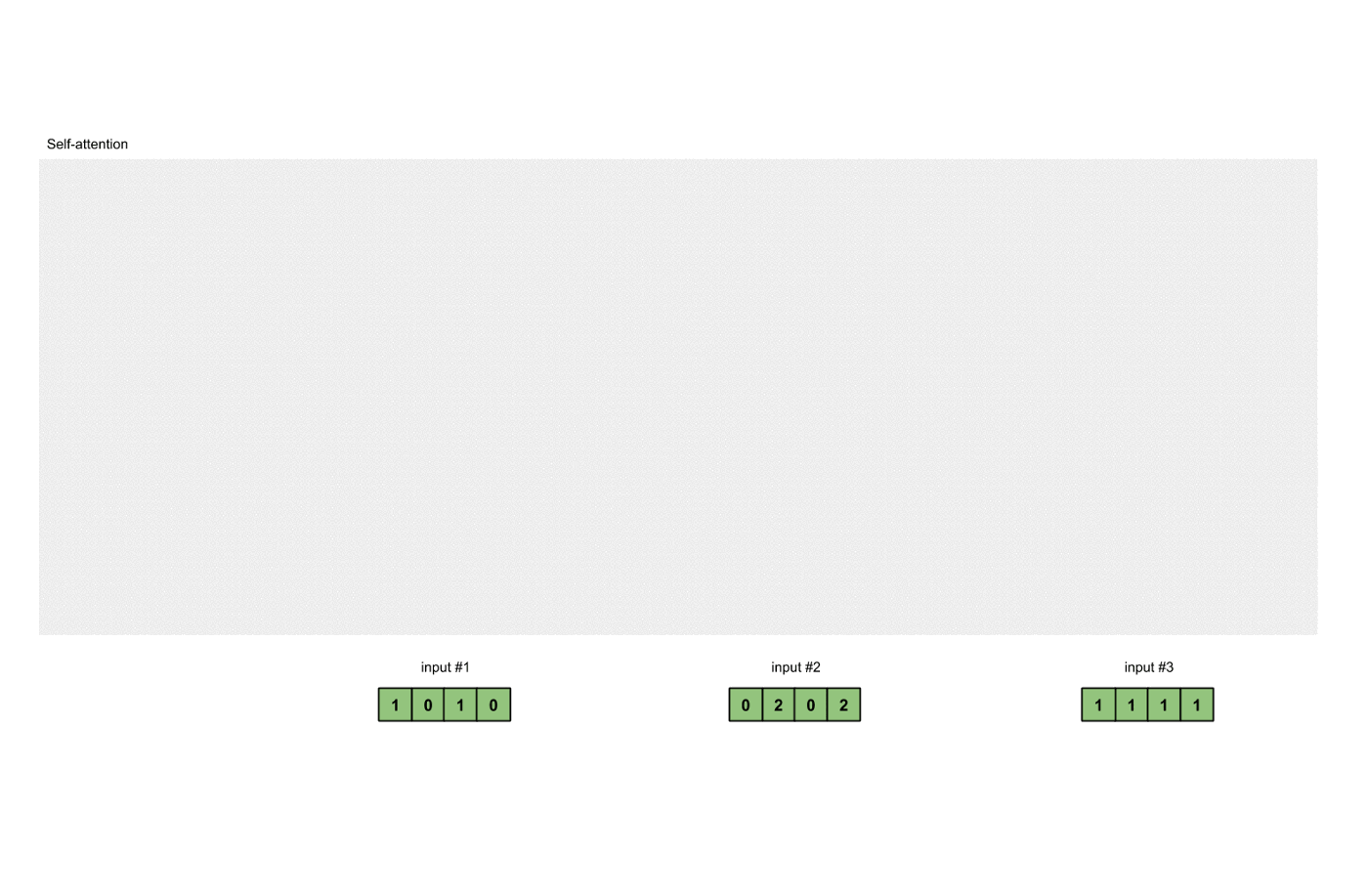
让我们用相同的操作来获取每个输入的value表示:

最后是query的表示:
[1, 0, 1]
[1, 0, 1, 0] [1, 0, 0] [1, 0, 2]
[0, 2, 0, 2] x [0, 0, 1] = [2, 2, 2]
[1, 1, 1, 1] [0, 1, 1] [2, 1, 3]
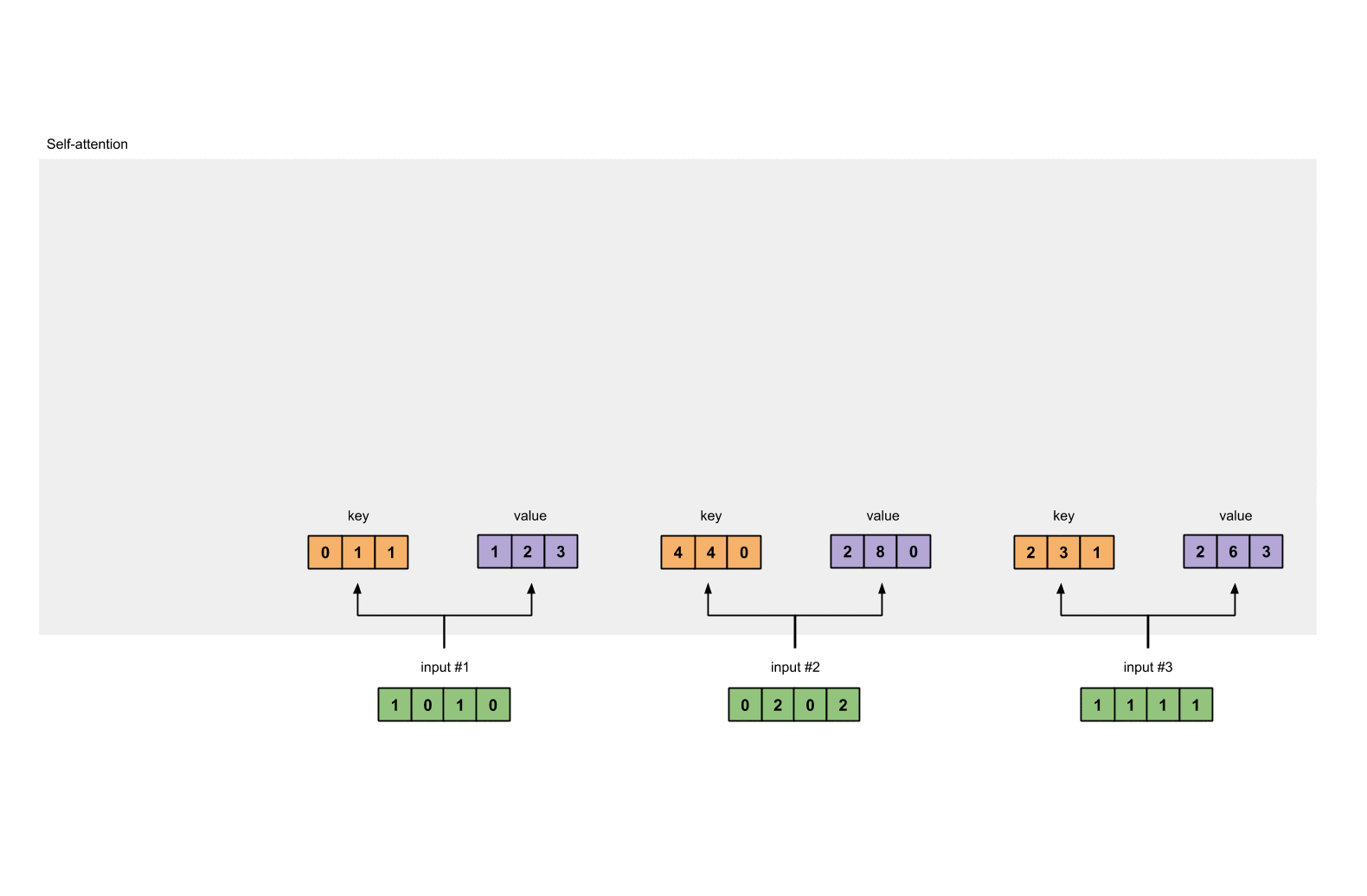
注意:实际上,一个偏重向量也许会加到矩阵相乘后的结果。
第四步:为第1个输入计算注意力分数

为了获取注意力分数,我们从输入1的query(红色)和所有keys(橙色)的点积开始。因为有3个key表示(这是由于我们有3个输入),我们得到3个注意力分数(蓝色)。
[0, 4, 2]
[1, 0, 2] x [1, 4, 3] = [2, 4, 4]
[1, 0, 1]
注意到我们只用了输入的query。后面我们会为其他的queries重复这些步骤。
第五步:计算softmax
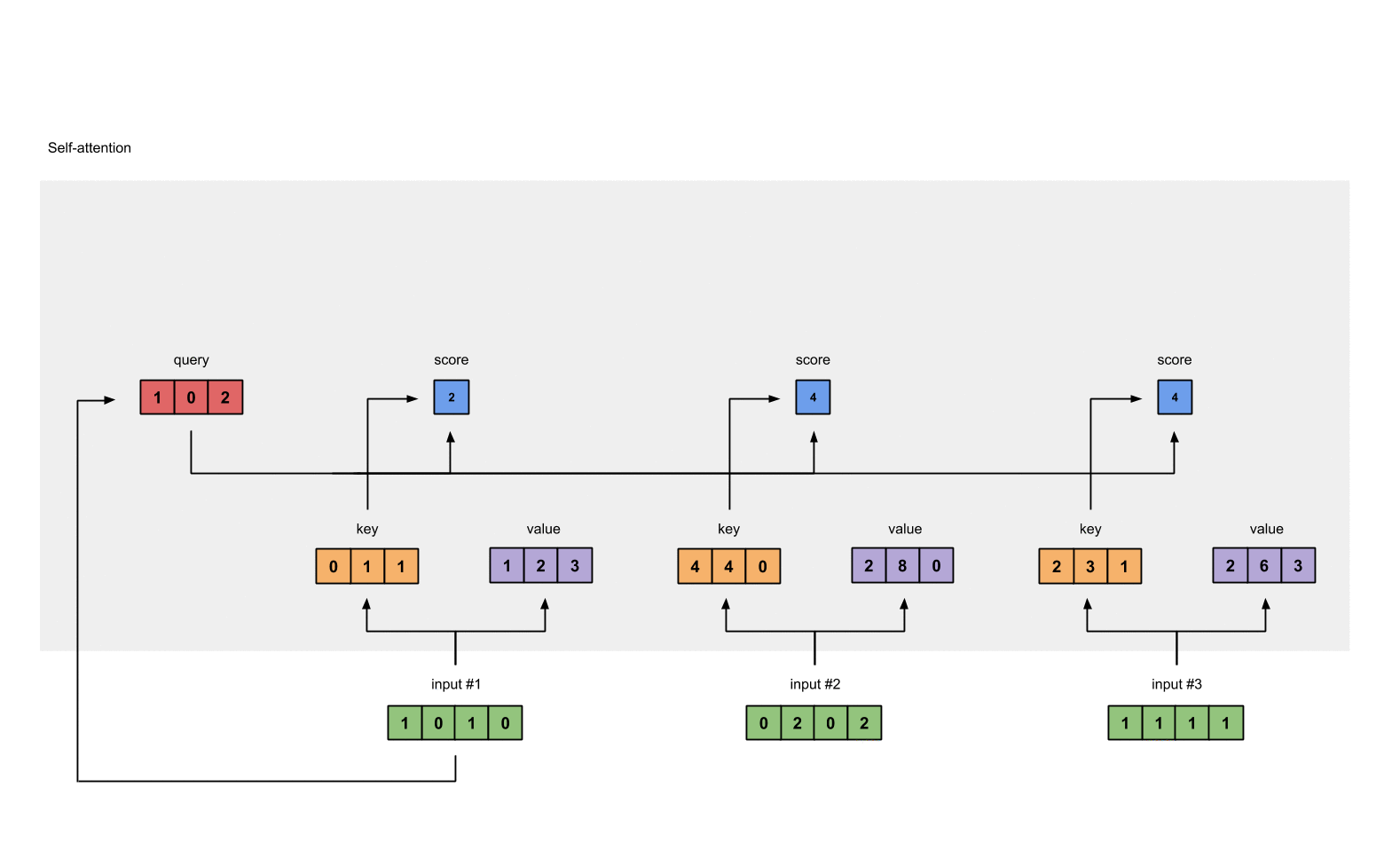
对这些注意力分数进行softmax函数运算(蓝色部分)。
softmax([2, 4, 4]) = [0.0, 0.5, 0.5]
第六步: 将分数乘以values

将每个输入(绿色)的softmax作用后的注意力分数乘以各自对应的value(紫色)。这会产生3个向量(黄色)。在这个教程中,我们把它们称作权重化value。
1: 0.0 * [1, 2, 3] = [0.0, 0.0, 0.0]
2: 0.5 * [2, 8, 0] = [1.0, 4.0, 0.0]
3: 0.5 * [2, 6, 3] = [1.0, 3.0, 1.5]
第七步:对权重化后的values求和,得到输出1
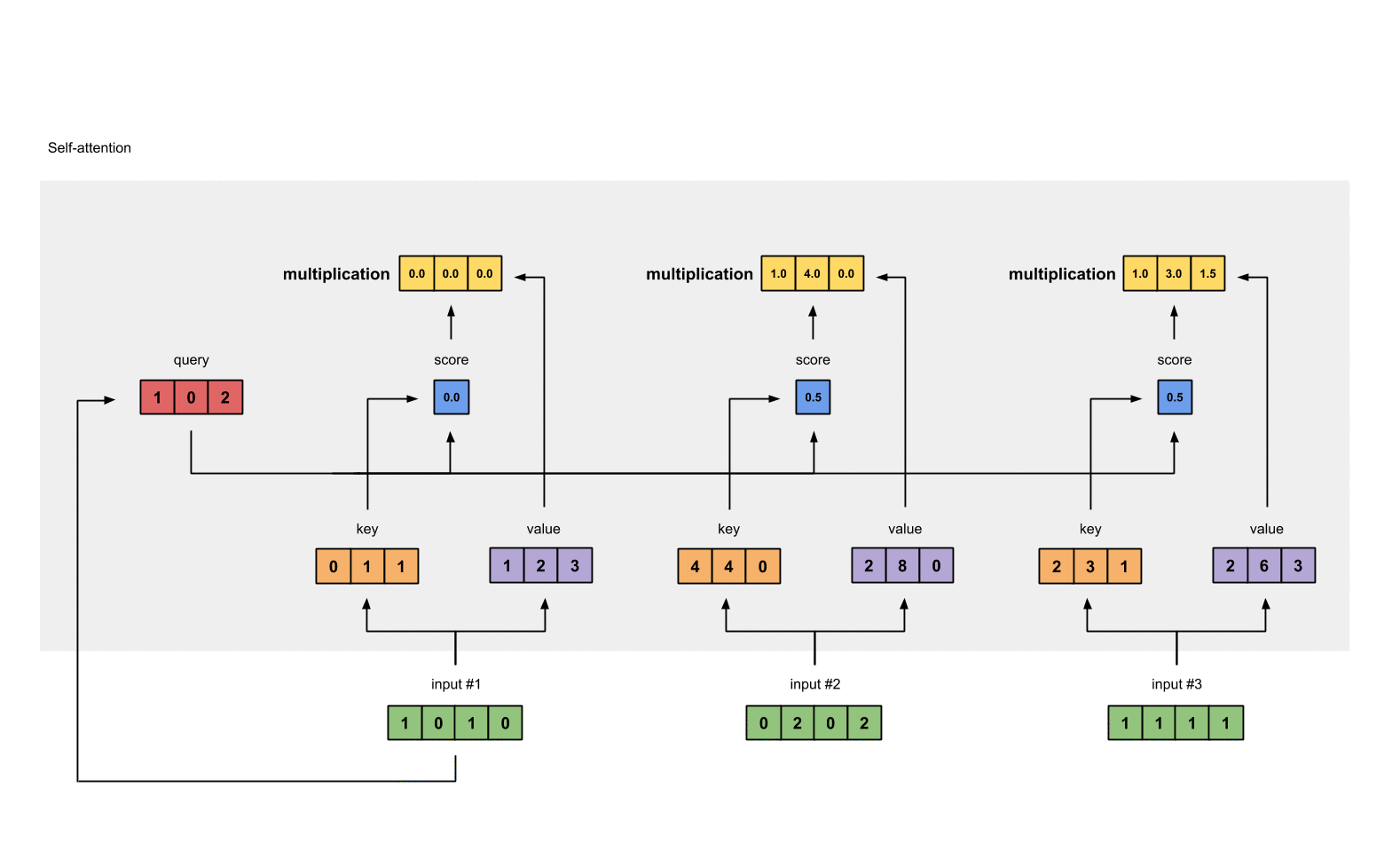
将权重后value按元素相加得到输出1:
[0.0, 0.0, 0.0]
+ [1.0, 4.0, 0.0]
+ [1.0, 3.0, 1.5]
-----------------
= [2.0, 7.0, 1.5]
产生的向量[2.0, 7.0, 1.5](暗绿色)就是输出1,这是基于输入1的query表示与其它的keys,包括它自身的key互相作用的结果。
第八步:对输入2、3,重复第4-7步
既然我们已经完成了输入1,我们重复步骤4-7能得到输出2和3。这个可以留给读者自己尝试,相信聪明的你可以做出来。

代码
这里有PyTorch的实现代码,PyTorch是一个主流的Python深度学习框架。为了能够很好地使用代码片段中的@运算符, .T and None操作,请确保Python≥3.6,PyTorch ≥1.3.1。
1. 准备输入
import torch
x = [
[1, 0, 1, 0], # Input 1
[0, 2, 0, 2], # Input 2
[1, 1, 1, 1] # Input 3
]
x = torch.tensor(x, dtype=torch.float32)
2. 初始化权重
w_key = [
[0, 0, 1],
[1, 1, 0],
[0, 1, 0],
[1, 1, 0]
]
w_query = [
[1, 0, 1],
[1, 0, 0],
[0, 0, 1],
[0, 1, 1]
]
w_value = [
[0, 2, 0],
[0, 3, 0],
[1, 0, 3],
[1, 1, 0]
]
w_key = torch.tensor(w_key, dtype=torch.float32)
w_query = torch.tensor(w_query, dtype=torch.float32)
w_value = torch.tensor(w_value, dtype=torch.float32)
3. 获取key,query和value
keys = x @ w_key
querys = x @ w_query
values = x @ w_value
print(keys)
# tensor([[0., 1., 1.],
# [4., 4., 0.],
# [2., 3., 1.]])
print(querys)
# tensor([[1., 0., 2.],
# [2., 2., 2.],
# [2., 1., 3.]])
print(values)
# tensor([[1., 2., 3.],
# [2., 8., 0.],
# [2., 6., 3.]])
4. 为第1个输入计算注意力分数
attn_scores = querys @ keys.T
# tensor([[ 2., 4., 4.], # attention scores from Query 1
# [ 4., 16., 12.], # attention scores from Query 2
# [ 4., 12., 10.]]) # attention scores from Query 3
5. 计算softmax
from torch.nn.functional import softmax
attn_scores_softmax = softmax(attn_scores, dim=-1)
# tensor([[6.3379e-02, 4.6831e-01, 4.6831e-01],
# [6.0337e-06, 9.8201e-01, 1.7986e-02],
# [2.9539e-04, 8.8054e-01, 1.1917e-01]])
# For readability, approximate the above as follows
attn_scores_softmax = [
[0.0, 0.5, 0.5],
[0.0, 1.0, 0.0],
[0.0, 0.9, 0.1]
]
attn_scores_softmax = torch.tensor(attn_scores_softmax)
6. 将分数乘以values
weighted_values = values[:,None] * attn_scores_softmax.T[:,:,None]
# tensor([[[0.0000, 0.0000, 0.0000],
# [0.0000, 0.0000, 0.0000],
# [0.0000, 0.0000, 0.0000]],
#
# [[1.0000, 4.0000, 0.0000],
# [2.0000, 8.0000, 0.0000],
# [1.8000, 7.2000, 0.0000]],
#
# [[1.0000, 3.0000, 1.5000],
# [0.0000, 0.0000, 0.0000],
# [0.2000, 0.6000, 0.3000]]])
7. 对权重化后的values求和,得到输出
outputs = weighted_values.sum(dim=0)
# tensor([[2.0000, 7.0000, 1.5000], # Output 1
# [2.0000, 8.0000, 0.0000], # Output 2
# [2.0000, 7.8000, 0.3000]]) # Output 3
注意:PyTorch已经提供了这个API,名字为
nn.MultiheadAttention。但是,这个API需要你提供PyTorch的Tensor形式的key,value,query。还有,这个模块的输出会经历一个线性变换。
自己实现?
以下是笔者自己写的部分。
对于不熟悉PyTorch的读者来说,上述的向量操作理解起来有点困难,因此,笔者自己用简单的Python代码实现了一遍上述Self-Attention的过程。
完整的Python代码如下:
# -*- coding: utf-8 -*-
from typing import List
import math
from pprint import pprint
x = [[1, 0, 1, 0], # Input 1
[0, 2, 0, 2], # Input 2
[1, 1, 1, 1] # Input 3
]
w_key = [[0, 0, 1],
[1, 1, 0],
[0, 1, 0],
[1, 1, 0]
]
w_query = [[1, 0, 1],
[1, 0, 0],
[0, 0, 1],
[0, 1, 1]
]
w_value = [[0, 2, 0],
[0, 3, 0],
[1, 0, 3],
[1, 1, 0]
]
# vector dot of two vectors
def vector_dot(list1: List[float or int], list2: List[float or int]) -> float or int:
dot_sum = 0
for element_i, element_j in zip(list1, list2):
dot_sum += element_i * element_j
return dot_sum
# get weights matrix by x, using matrix multiplication
def get_weights_matrix_by_x(x, weight_matrix):
x_matrix = []
for i in range(len(x)):
x_row = []
for j in range(len(weight_matrix[0])):
x_row.append(vector_dot(x[i], [_[j] for _ in weight_matrix]))
x_matrix.append(x_row)
return x_matrix
# softmax function
def softmax(x: List[float or int]) -> List[float or int]:
x_sum = sum([math.exp(_) for _ in x])
return [math.exp(_)/x_sum for _ in x]
x_key = get_weights_matrix_by_x(x, w_key)
x_value = get_weights_matrix_by_x(x, w_value)
x_query = get_weights_matrix_by_x(x, w_query)
# print(x_key)
# print(x_value)
# print(x_query)
outputs = []
for query in x_query:
score_list = [vector_dot(query, key) for key in x_key]
softmax_score_list = softmax(score_list)
weights_list = []
for i in range(len(softmax_score_list)):
weights = [softmax_score_list[i] * _ for _ in x_value[i]]
weights_list.append(weights)
output = []
for j in range(len(weights_list[0])):
output.append(sum([_[j] for _ in weights_list]))
outputs.append(output)
pprint(outputs)
输出结果如下:
[[1.9366210616669624, 6.683105308334811, 1.5950684074995565],
[1.9999939663351456, 7.9639915951322156, 0.0539764053125496],
[1.9997046127769653, 7.759892254657784, 0.3583892946751152]]
总结
本文主要讲述了如何一步一步来实现Self-Attention机制,对于想要自己实现算法的读者来说,值得一读。
本文分享到此结束,感谢大家的阅读~